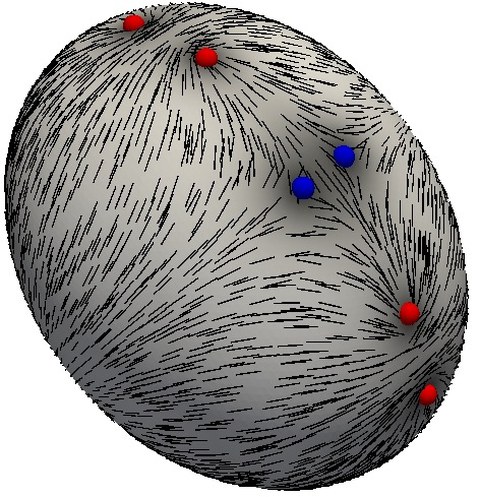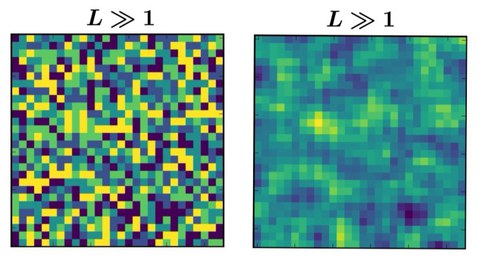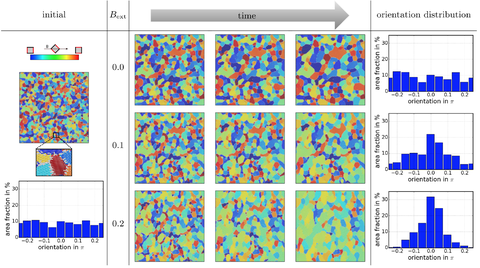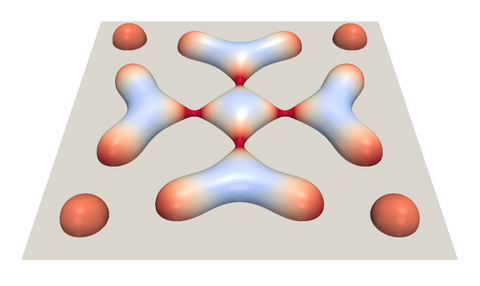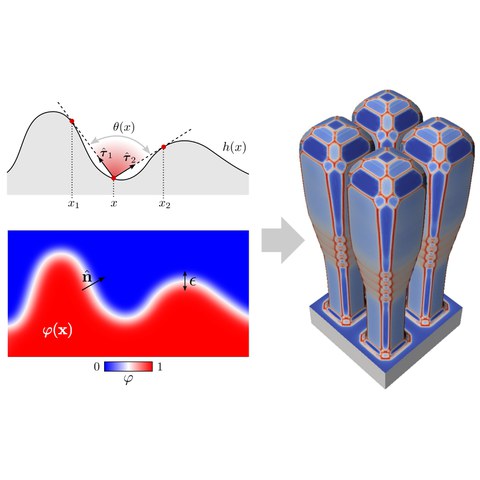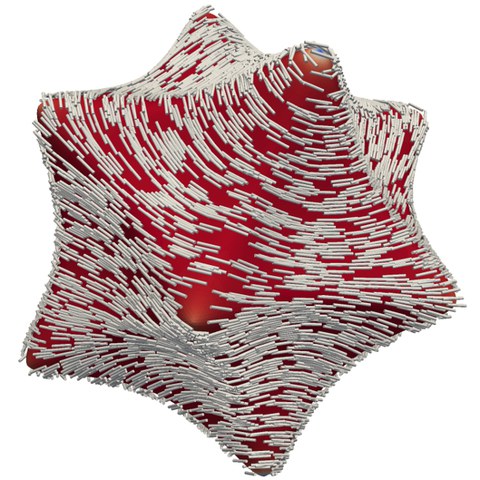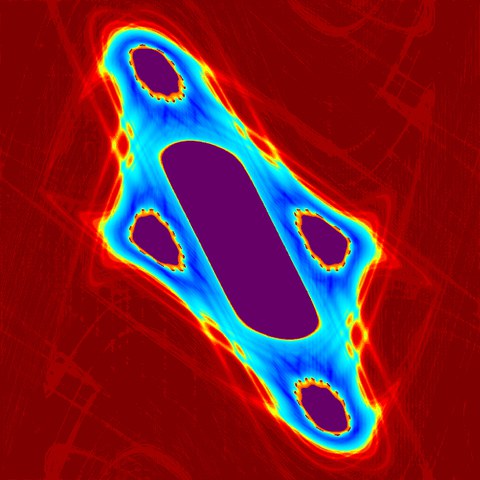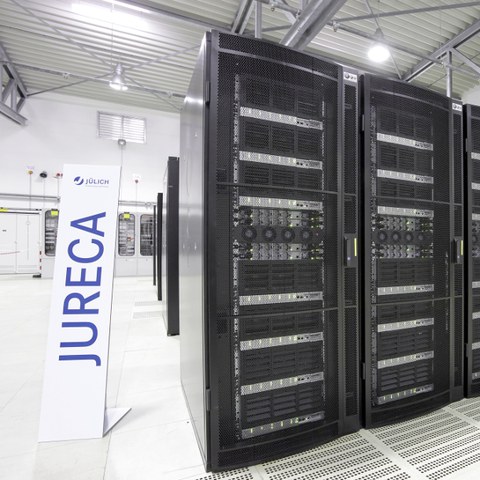Projekte des Instituts
Inhaltsverzeichnis
Aktuelle Projekte
Most of the work on PDEs that are defined on curved surfaces is concerned with scalar-valued equations. In this case the coupling between surface geometry and the PDE is weak, and thus numerical approaches established in flat spaces are applicable after small modifications. For vector- and tensor-valued surface PDEs these approaches are no longer sufficient. The surface vector- and tensor-fields need to be considered as elements of the tangent bundle, and thus the coupling between surface geometry and the PDE becomes more severe. Progress on this topic is currently made in different communities and in the course of studying specific problems from different application areas, including fluid dynamics, materials science, mechanics, and biophysics. mehr
Polycrystalline composites, reinforced rubber and biological tissue are examples of random heterogeneous materials (RM). The properties of RM on very small length scales are described by statistical information, e.g., distribution of grains/inclusions, geometry, etc. Oftentimes RM feature a peculiar effective behaviour on large length mehr
The objective of the present SPP is to develop a unified description of matter transport activated in inorganic solid materials by electric and magnetic fields. One central question of the SPP is therefore: What are the interplays between static electric / magnetic fields as well as (dynamic) electromagnetic fields and defect formation, structure and mobility? mehr
NARCISO “NAtuRal instability of semiConductors thIn SOlid films for sensing and photonic applications” is an interdisciplinary project merging physics, chemistry, material science, fluid dynamics, and photonics with a high potential for applications and industrial scale-up of the relevant results. mehr
µSPIRE aims at establishing a technological platform for homo- and hetero-structure based photonic and electronic devices using the self-assembling of epitaxial crystals on patterned Si substrates. Emerging micro-electronic and photonic devices strongly require the integration on Si of a variety of semiconducting materials such as Ge, GaAs, GaN and SiC, in order to add novel functionalities to the Si platform. µSpire pursues this goal mehr
Flüssigkristalline Systeme zeigen ein reichhaltiges Phasenverhalten im Gleichgewicht, welches mit Hilfe von Computersimulationen und statistischen Theorien im Volumen (d.h. im nichtgekrümmten Raum) mittlerweile immer besser verstanden ist. Flüssigkristalle können aber auch auf gekrümmte Mannigfaltigkeiten eingeschränkt werden, wobei sich dann topologische Defekte ergeben. mehr
Hamiltonsche Systeme weisen normaler-weise einen gemischten Phasenraum mit Regionen geprägt von regelmäßigem oder chaotischem Verhalten auf. Solch dynamisch unterschiedliche Regionen können durch invariante Kurven oder Ober-flächen komplett getrennt werden. Zusätzlich existieren partielle Barrieren. Diese Barrieren sind durchlässig, aber schwer für Trajektorien zu durchqueren und dementsprechend beeinflussen sie die Transporteigenschaften des mehr
Our research goals are related to improvements of the parallel adaptive finite element (FEM) library AMDiS and its use in various applications in problems in materials science and biophysics. The application part uses the phase field crystal (PFC) model, which can be viewed as a local approximation to classical dynamic density functional theory (DDFT). mehr
Abgeschlossene Projekte
| Drittmittelgeber | Projekttitel | Laufzeit |
|---|---|---|
| DFG |
Hochauflösende thermo-elastische Simulation auf massiv-parallelen Rechnerarchitekturen |
07/2011 - 06/2019 |
| CoSiMa |
Simulation von RT-CVD für Graphen und andere zwei-dimensionale Materialien |
10/2015 - 09/2018 |
| CoSiMa |
Simulationsmethoden für komplexe Fluide und weiche Materialien |
10/2015 - 09/2018 |
| DFG SFB/TR79 | Werkstoffe für die Geweberegeneration im systemisch erkrankten Knochen | 07/2010 - 06/2018 |
| DFG SPP 1506 |
Surface viscosity in multiphase flow - modeling, numerical analysis and simulations |
05/2013 - 04/2018 |
| DFG |
Mathematical modeling and numerical simulation of cells and systems |
11/2012 - 10/2017 |
| DFG SPP 1506 |
A diffuse-interface approach for coupled bulk/surface systems in multiphase flow |
05/2010 - 12/2016 |
| BMBF HPC-OM | 08/2013 - 07/2016 | |
| DFG Exzellenzinitiative | 08/2013 - 07/2016 | |
| TU Dresden support-the-best |
04/2014- 05/2016 | |
| DFG SPP 1506 |
A diffuse interface model for multiphase flow with surface-active particles |
05/2013 - 04/2016 |
| DFG SPP 1296 |
A continuum model for heterogeneous nucleation - atomistic simulations on diffusive time scales |
08/2007- 04/2016 |
| EU FP7 IRSES | Phasefield | 12/2011- 11/2015 |
| DFG | Experimental and theoretical investigations to increase the process efficiency and quality of the cutting edge of inert gas welding with fiber laser together with E. Beyer |
06/2011- 05/2014 |
| DFG | Geometric evolution towards the understanding of biomembranes | 05/2007- 04/2014 |
| DFG SFB 609 C10 | Influencing the morphology and composition of electrochemically deposited layers by magnetic fields |
01/2008- 12/2012 |
| DFG SFB 609 A10 | Adjoint-based control of turbulent flows byelectromagnetic fields | 01/2009- 12/2012 |
| BMWi ZIM | Calculation methods for process analysis of thick matter handling systems |
10/2010- 10/2011 |
| DFG | From surface instabilities to nanostructures: numerical investigations | 01/2009- 06/2011 |
| SAB | Seed stipendium | 01/2010- 12/2010 |
| DFG SPP 1253 | Control of nanostructures through electric fields together with F. Haußer |
03/2007- 05/2010 |
| EU/NSF 6th FP NMP | Bridging atomistic to continuum scales - Multiscale investigation of self-assembling magnetic dots in epitaxial growth - MagDot together with T. Ala-Nissilä, O. Fruchart, M. Kotrla, J. Lowengrub, K. Thornton, P.W. Voorhees |
01/2006- 12/2009 |
| BMWi | SmartSoft | 12/2008- 11/2009 |
| DFG | Macro- and micro-fluid-mechanics (CFD) of the cochlea | 10/2008- 05/2009 |
| DFG SFB 611 | Epitaxy together with F. Otto |
01/2005- 12/2008 |
| BMBF | Continuum models for epitaxial growth of SiGe together with F. Otto |
05/2004- 04/2007 |
| DFN VIOLA |
TechSim - Distributed simulations of complex technological systems together with B. Steckel |
05/2004- 04/2007 |
| DFG SPP 1095 | Thermal decay of nanostructures and Ostwald ripening of homoepitaxial monolayers | 01/2005- 12/2006 |
| DFG SFB 611 | Point defects together with M. Griebel |
01/2002- 12/2004 |

